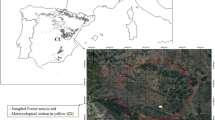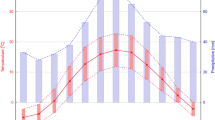Abstract
Geographical variation in climatic cues for masting of Fagus crenata Blume, which is the most dominant tree species in Japanese temperate forests, was investigated in the northern part of Japan, i.e., the Tohoku district of Honshu Island and the Oshima Peninsula of Hokkaido Island. The data obtained after an 18-year assessment (1989–2006) of 163 stands, covering an area of ca. 200 × 500 km2 area, were used in this study. In all stands, mast seeding occurred three times (1995, 2000 and 2005) during the study period and the coefficient of annual variation (CV) in seedfall density was 0.94. Based on cluster analysis, the stands were classified into each of the seven groups, in which the seedfall density was temporally synchronized among the stands and showed higher values of CV (1.04–1.79). These groups were distributed spatially exclusively at the scale of 80–200 km. By selecting the tree model based on AIC values, lower temperature in spring, higher temperature in summer and seedfall density in a year were proved to have a decisive influence on the seedfall density in the subsequent year. The effects of the first two climatic cues overwhelm that of the seedfall density. Lower temperature in spring served as a cue mostly for the population in the Oshima Peninsula, while higher temperature in summer served as a cue for the populations in the Tohoku district. If this suggests a genetic variation in relation to cues, climatic changes (e.g., global warming) will have different impacts on seed production of different F. crenata populations. However, it remains to be tested in future studies whether multiple climatic cues simply reflect regionally variable climatic conditions or not.






Similar content being viewed by others
References
Ashton P, Givnish T, Appanah S (1988) Staggered flowering in the Dipterocarpaceae: new insights into floral induction and the evolution of mast fruiting in the aseasonal tropics. Am Nat 132:44–66. doi:10.1086/284837
Crawley M (2002) Statistical computing: an introduction to data analysis using S-Plus. Wiley, West Sussex
Fujii N, Tomaru N, Okuyama K, Koike T, Mikami T, Ueda K (2002) Chloroplast DNA phylogeography of Fagus crenata (Fagaceae) in Japan. Plant Syst Evol 232:21–33. doi:10.1007/s006060200024
Hoshizaki K, Hulme P (2002) Mast seeding and predator-mediated indirect interactions in a forest community: evidence from post-dispersal fate of rodent-generated caches. In: Levey D, Silva W, Galleti M (eds) Seed dispersal and frugivory: ecology, evolution and conservation. CABI Publishing, Wallingford, pp 227–239
Hoshizaki K, Miguchi H (2005) Influence of forest composition on tree seed predation and rodent responses: a comparison of monodominant and mixed temperate forests in Japan. In: Forget PM, Lambert J, Hulme P, Van der Wall S (eds) Seed fate: predation, dispersal and seedling establishment. CABI Publishing, Wallingford, pp 253–267
Igarashi Y, Kamata N (1997) Insect predation and seasonal seedfall of the Japanese beech, Fagus crenata Blume, in northern Japan. J Appl Entomol 121:65–69
Isagi Y, Sugimura K, Sumida A, Ito H (1997) How does masting happen and synchronize? J Theor Biol 187:231–239. doi:10.1006/jtbi.1997.0442
Kelly D (1994) The evolutionary ecology of mast seeding. Trends Ecol Evol 9:465–470. doi:10.1016/0169-5347(94)90310-7
Kelly D, Harrison A, Lee W, Payton I, Wilson P, Schauber E (2000) Predator satiation and extreme mast seeding in 11 species of Chionochloa (Poaceae). Oikos 90:477–488. doi:10.1034/j.1600-0706.2000.900306.x
Kobro S, Søreide L, Djønne E, Rafoss T, Jaastad G, Witzgall P (2003) Masting of rowan Sorbus aucuparia L. and consequences for the apple fruit moth Argyresthia conjugella Zeller. Popul Ecol 45:25–30
Kon H, Noda T (2007) Experimental investigation on weather cues for mast seeding of Fagus crenata. Ecol Res 22:802–806. doi:10.1007/s11284-006-0320-5
Kon H, Noda T, Terazawa K, Koyama H, Yasaka M (2005a) Evolutionary advantages of mast seeding in Fagus crenata. Ecology 93:1148–1155. doi:10.1111/j.1365-2745.2005.01040.x
Kon H, Noda T, Terazawa K, Koyama H, Yasaka M (2005b) Proximate factors causing mast seeding in Fagus crenata: the effects of resource level and weather cues. Can J Bot 83:1402–1409. doi:10.1139/b05-120
Koyama H, Yasaka M, Terazawa K, Kon H (2000) The effect of site preparation timing on regeneration success of beech (Fagus crenata Blume): a demonstration of practical use value of seed crop prediction method. J Jpn For Soc 82:39–43 (in Japanese with English summary)
Koyama H, Terazawa K, Yasaka M, Kon H (2004) Ecology based prediction of seed crop size for successful natural regeneration of Fagus crenata in northern Japan; development of prototype for prediction. In: Sagheb-Talebi K, Madsen P, Terazawa K (eds) Improvement and silviculture of beech. Proceedings from the 7th international beech symposium. Research Insitute of Forests and Rangelands, Iran, pp 124–127
Lalonde R, Roitberg B (1992) On the evolution of masting behavior in trees: predation or weather? Am Nat 139:1293–1304. doi:10.1086/285387
Masaka K (2001) Modelling the masting behaviour of Betula platyphylla var. japonica using the resource budget model. Ann Bot (Lond) 88:1049–1055. doi:10.1006/anbo.2001.1547
Masaki T, Sugita H, Kanazashi T, Nagaike T, Ota T, Hitsuma G, et al (2003) Results of different managements for natural regeneration of two beech forests in Tohoku district and their ecological process. J Jpn For Soc 85:259–264 (in Japanese with English summary)
Matsui T, Yagihashi T, Nakaya T, Tanaka N, Taoda H (2004) Climatic controls on distribution of Fagus crenata forests in Japan. J Veg Sci 15:57–66. doi:10.1658/1100-9233(2004)015[0057:CCODOF]2.0.CO;2
McKone M, Kelly D, Lee W (1998) Effect of climate change on mast-seeding species: frequency of mass flowering and escape from specialist insect seed predators. Glob Chang Biol 4:591–596. doi:10.1046/j.1365-2486.1998.00172.x
Mikami S, Kitakami Y (1983) Phenological studies on reproductive development in Fagus crenata BL. Bull For Tree Breed Inst 1:1–14 (in Japanese with English summary)
Monks A, Kelly D (2006) Testing the resource-matching hypothesis in the mast seeding tree Nothofagus truncata (Fagaceae). Aust J Ecol 31:366–375. doi:10.1111/j.1442-9993.2006.01565.x
Nakashizuka T (1984) Regeneration process of climax beech (Fagus crenata Blume) forests. V. Population dynamics of beech in a regeneration process. Jpn J Ecol 34:411–419
Nanami S, Kawaguchi H, Yamakura T (1999) Dioecy-induced spatial patterns of two codominant tree species, Podocarpus nagi and Neolitsea aciculate. J Ecol 87:678–687. doi:10.1046/j.1365-2745.1999.00392.x
Oka T (2006) Regional concurrence in the number of culled Asiatic black bears, Ursus thibetanus. Mammal Study 31:79–85 doi:10.3106/1348-6160(2006)31[79:RCITNO]2.0.CO;2
Oka T, Miura S, Masaki T, Suzuki W, Osumi K, Saitoh S (2004) Relationship between changes in beechnut production and Asiatic black bears in northern Japan. J Wildl Manage 68:979–986. doi:10.2193/0022-541X(2004)068[0979:RBCIBP]2.0.CO;2
Piovesan G, Adams J (2001) Masting behaviour in beech: linking reproduction and climatic variation. Can J Bot 79:1039–1047 doi:10.1139/cjb-79-9-1039
Piovesan G, Adams J (2005) The evolutionary ecology of masting: does the environmental prediction hypothesis also have a role in mesic temperate forests? Ecol Res 20:739–743. doi:10.1007/s11284-005-0096-z
R Development Core Team (2006) R: a language and environment for statistical computing. R Foundation for Statistical Computing, Vienna, Austria
Rees M, Kelly D, Bjørnstad O (2002) Snow tussocks, chaos, and the evolution of mast seeding. Am Nat 160:44–59. doi:10.1086/340603
Sakai S (2002) General flowering in lowland mixed dipterocarp forests of South-east Asia. Biol J Linn Soc 75:233–247
Sakai S, Harrison R, Momose K, Kuraji K, Nagamasu H, Yasunari T, et al (2006) Irregular droughts trigger mass flowering in aseasonal tropical forests in Asia. Am J Bot 93:1134–1139. doi:10.3732/ajb.93.8.1134
Satake A, Iwasa Y (2002a) Spatially limited pollen exchange and a long-range synchronization of trees. Ecology 83:993–1005
Satake A, Iwasa Y (2002b) The synchronized and intermittent reproduction of forest trees is mediated by the Moran effect, only in association with pollen coupling. J Ecol 90:830–838. doi:10.1046/j.1365-2745.2002.00721.x
Schauber EM, Kelly D, Turchin P, Simon C, Lee WG, Allen RB, et al (2002) Masting by eighteen New Zealand plant species: the role of temperature as a synchronizing cue. Ecology 83:1214–1225
Schnurr J, Ostfeld R, Canham C (2002) Direct and indirect effects of masting on rodent populations and tree seed survival. Oikos 96:402–410. doi:10.1034/j.1600-0706.2002.960302.x
Seløas V (2000) Seed production of a masting dwarf shrub, Vaccinium myrtillus, in relation to previous reproduction and weather. Can J Bot 78:423–429. doi:10.1139/cjb-78-4-423
Seløas V, Piovesan G, Adams J, Bernabei M (2002) Climatic factors controlling reproduction and growth of Norway spruce in southern Norway. Can J Res 32:217–225. doi:10.1139/x01-192
Shibata M, Tanaka H, Nakashizuka T (1998) Causes and consequences of mast seed production of four co-occurring Carpinus species in Japan. Ecology 79:54–64
Shibata M, Tanaka H, Iida S, Abe S, Masaki T, Niiyama K, et al (2002) Synchronized annual seed production by 16 principal tree species in a temperate deciduous forest, Japan. Ecology 83:1727–1742
Shimatani K (2001) Point process approach to statistical analysis and modeling for tree distribution maps. Jpn J Ecol 51:87–106 (in Japanese with English summary)
Suzuki W, Osumi K, Masaki T (2005) Mast seeding and its spatial scale in Fagus crenata in northern Japan. For Ecol Manage 205:105–116
Terazawa K, Yasaka M, Koyama H, Kon H (2004) Prediction of seed crop size for successful natural regeneration of Fagus crenata Blume in northern Japan. In: Sagheb-Talebi K, Madsen P, Terazawa K (eds) Improvement and silviculture of beech: Proceedings from the 7th international beech symposium. Research Insitute of Forests and Rangelands, Iran, pp 120–123
Yasaka M, Koyama H, Terazawa K, Kon H (2001) A prediction method for beech (Fagus crenata) mast based on winter bud investigation. J Jpn For Soc 83:322–327 (in Japanese with English summary)
Yasaka M, Terazawa K, Koyama H, Kon H (2003) Masting behavior of Fagus crenata in northern Japan: spatial synchrony and pre-dispersal seed predation. For Ecol Manage 184:277–284
Acknowledgments
The authors thank the foresters of the Tohoku Regional Forest Office for assessing seed production and providing the data. We are also very grateful to Dr. A. Satake for her useful suggestions throughout the study and to Dr. T. Matsui for his assistance in constructing the tree model. The AMeDAS data were obtained from the numeric data-base at the Computer Center for Agriculture, Forestry and Fisheries Research, MAFF, Japan. The data on seed production of Fagus crenata in the Tohoku district were obtained from the website of the Forestry and Forest Products Research Institute (http://www.ffpri.affrc.go.jp/labs/tanedas/, in Japanese). This study was partly funded by the Ministry of the Environment, Japan (“The study project on the Japanese black bears’ mass intrusion into human settlements”).
Author information
Authors and Affiliations
Corresponding author
Additional information
This manuscript was submitted for the special feature based on the symposium in Jozankei, Hokkaido, held on 21 October 2007.
Rights and permissions
About this article
Cite this article
Masaki, T., Oka, T., Osumi, K. et al. Geographical variation in climatic cues for mast seeding of Fagus crenata . Popul Ecol 50, 357–366 (2008). https://doi.org/10.1007/s10144-008-0104-6
Received:
Accepted:
Published:
Issue Date:
DOI: https://doi.org/10.1007/s10144-008-0104-6




